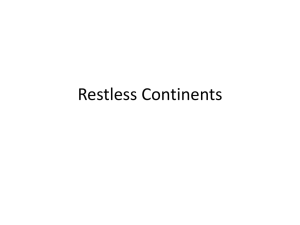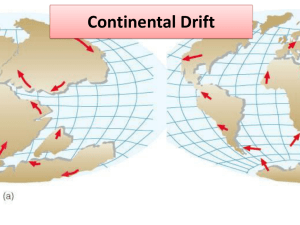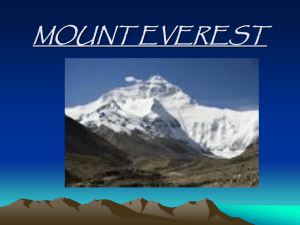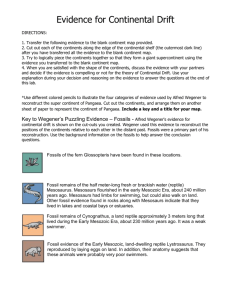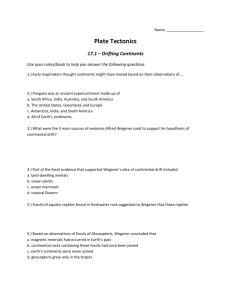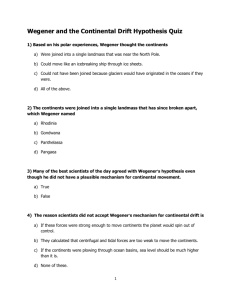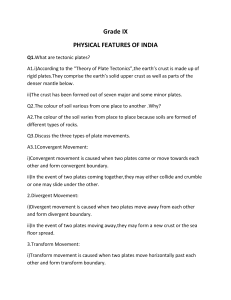Drifting Continents Chapter 5 Lesson 1
advertisement
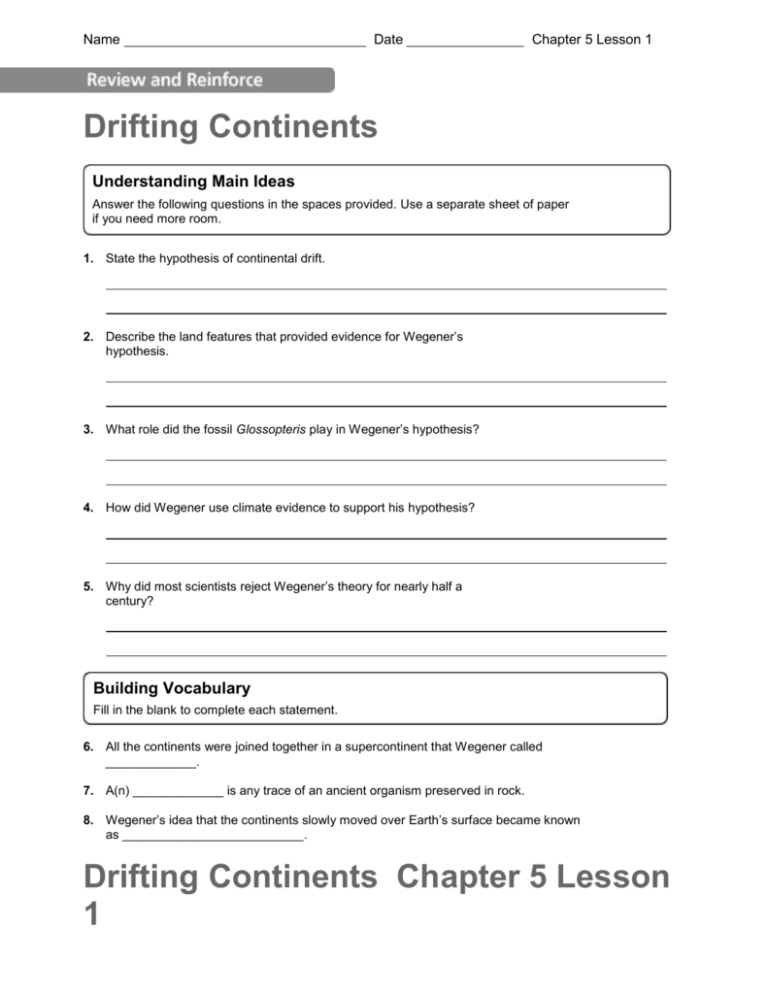
Name Date Chapter 5 Lesson 1 Drifting Continents Understanding Main Ideas Answer the following questions in the spaces provided. Use a separate sheet of paper if you need more room. 1. State the hypothesis of continental drift. 2. Describe the land features that provided evidence for Wegener’s hypothesis. 3. What role did the fossil Glossopteris play in Wegener’s hypothesis? 4. How did Wegener use climate evidence to support his hypothesis? 5. Why did most scientists reject Wegener’s theory for nearly half a century? Building Vocabulary Fill in the blank to complete each statement. 6. All the continents were joined together in a supercontinent that Wegener called _____________. 7. A(n) _____________ is any trace of an ancient organism preserved in rock. 8. Wegener’s idea that the continents slowly moved over Earth’s surface became known as __________________________. Drifting Continents Chapter 5 Lesson 1 Study the map and read the passage. Then use a separate sheet of paper to answer the questions that follow. The Curious Case of Mesosaurus About 265 million years ago, a reptile called Mesosaurus lived in just a few places on earth. This fairly small, lizard-like reptile measured 71 centimeters from its nose to the tip of its tail—or about two thirds of a meter. Its body was long and flexible, perfect for swimming swiftly through the water. Mesosaurus was a hunter of small fish and other aquatic animals. Its webbed feet and long tail worked like powerful paddles as it chased and captured its food. Like all other reptiles, Mesosaurus breathed air, so it had to return to the surface after hunting underwater. Freshwater ponds and lakes were its habitat. In the 1800s, scientists began finding fossils of these ancient reptiles, which had long since become extinct. These fossils were found in only two regions, southern Africa and the southern part of south America. The shaded areas on the map show where fossils of Mesosaurus have been discovered. This distribution is a curious one—only two regions far from each other and separated by the Atlantic Ocean. What could explain this distribution? 1. Describe the kind of environment in which Mesosaurus lived. 2. Is it likely that Mesosaurus swam back and forth across the Atlantic Ocean? Explain. 3. What could explain the distribution of Mesosaurus fossils? 4. Does the case of Mesosaurus support Wegener’s theory of continental drift? Explain why or why not. 5. Does the case by itself prove the theory? Explain why or why not. Name Date Chapter 5 Lesson 2 Sea-Floor Spreading Study the map and read the passage. Then use a separate sheet of paper to answer the questions that follow. The Birth of the Himalayas The greatest challenge for mountain climbers is Mt. Everest, whose peak rises 8,872 meters above sea level. This is the highest mountain in the world, though many mountains around it are almost as high. Mt. Everest is in the Himalayas, a series of massive ranges that extends 2,500 kilometers across South Asia north of India. The Himalayas cover all or part of the countries of Tibet, Nepal, and Bhutan. A climber on the high slopes of Mt. Everest would probably be surprised to learn that the region was relatively flat about 40 million years ago. It was then that two continental plates collided. The plate carrying India had been moving northwards for millions of years. The oceanic crust in front of it was slowly subducted under the Eurasian plate. But when the two continents collided, subduction stopped because the plate carrying India did not sink into the mantle. Instead, it pushed crust upward and downward. The Himalayas were one result. Thus, the Himalayas are actually pieces of plates broken and lifted up because of the collision. Another result of this collision was the movement of China eastward, as the movement of India northward pushed the Eurasian plate in front of it. The collision is still occurring today. In fact, the Himalayas are growing in elevation at a rate of about 1 centimeter per year. 1. 2. 3. 4. 5. 6. What are the Himalayas? What was the area of the Himalayas like 40 million years ago? How did the movement of plates create the Himalayas? What else resulted from the collision of those plates? What type of plate boundary exists today along the Himalayas? If the Himalayas continue to grow in elevation at their present rate, how tall will Mt. Everest be in another one million years? Name Date Class Sea-Floor Spreading Write the letter of the correct answer on the line at the left. 1. ___ Which features form the longest mountain ranges on Earth? A the mid-ocean ridges B the deep-ocean trenches C the Rockies D the Andes 2. ___ Which process adds more crust to the ocean floor? A suction B sea-floor spreading C subduction D magnetic stripe 3. ___ Where does subduction occur? A along the middle of some ocean floors B down the middle of mountain ranges C on continents D at deep-ocean trenches 4. ___ Which process or processes change the size and shape of the oceans? A subduction only B sea-floor spreading only C both subduction and sea-floor spreading D both drilling for samples and subduction If the statement is true, write true. If the statement is false, change the underlined word or words to make the statement true. 5. _____________ Sonar is a device that scientists use to map the ocean floor. 6. _____________ A deep-ocean trench is an underwater mountain. 7. _____________ Molten material erupts inside the central valley of mid-ocean ridges. 8. _____________ The farther from a midocean ridge a rock sample is taken, the younger the rock is. 9. _____________ Sea-floor spreading occurs at mid-ocean ridges. 10. _____________ The pattern of magnetic stripes in rocks on either side of a mid-ocean ridge is the same.
